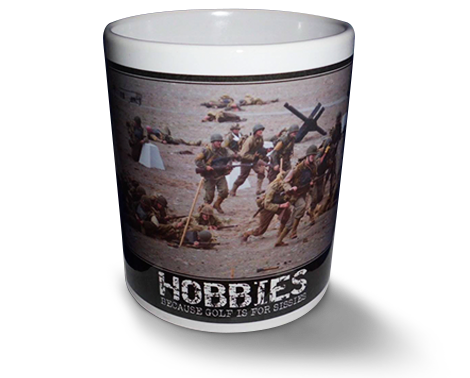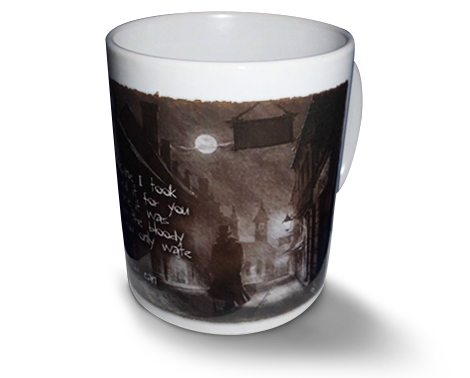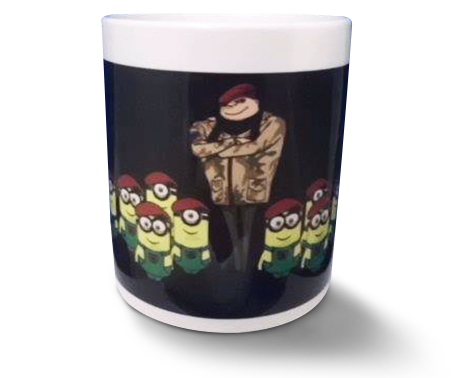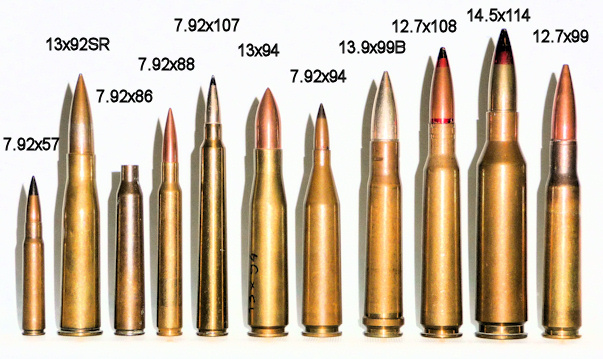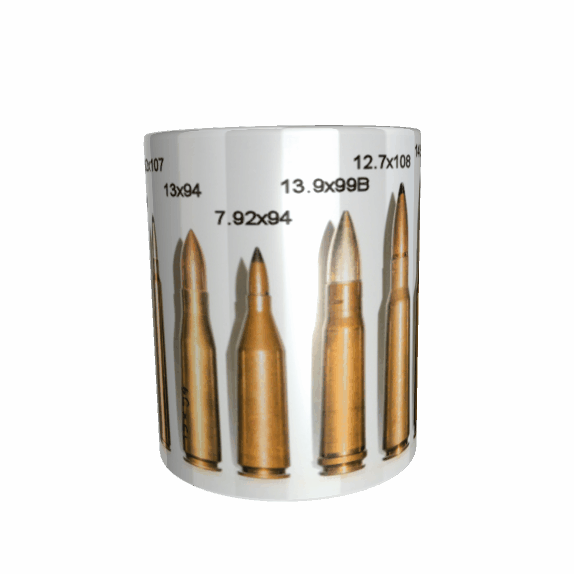11 oz Military Ammunition mug
Perfect gift for military enthusiast
Ammunition may be an intimidating subject if you are not knowledgeable within the firearm branch. deciding on the right ammunition to your firearms whether or not for looking or private protection is an crucial decision. Having the right ammunition is important to maintaining your firearm safe at the same time as having most appropriate overall performance. This subject matter may be overwhelming and perplexing however we've got simplified it for you.
Ammunition is preferred indicated in a dimension. the us industrial market uses a united statestrendy measurement while maximum of the sector makes use of a metric gadget. The measurements in metric are almost continually a “diameter to length” ratio. for instance: five.56x45mm is five.56mm huge and 45mm long. Shotshells are measured in “gauge”, with a lower variety being a bigger in diameter. as an instance: a regular 12 gauge shell is 70mm long, which matches out to be 2½”.
elements of a Cartridge
A cartridge is made of four additives: case, primer, powder/propellant, and projectile.
Case
The case is usually crafted from brass, nickel, or steel.
Primer
that is the ignition for the propellent, see the spherical dimple on the bottom of the cartridge.
Powder/Propellant
this is the gunpowder.
Projectile
that is the best a part of the cartridge that is the actual bullet.
varieties of Bullets
Bullets are available in a spread of kinds which can be used for extraordinary purposes. each bullet is normally noted by means of it’s suffixed acronym making The one-of-a-kind kinds of bullets are listed and pictured beneath.
Lead spherical nose (LRN)
Wad Cutter (WC)
Semi Wad Cutter (SWC)
Semi-Jacketed (SJ)
complete steel Jacket (FMJ)
Semi-Jacketed hole point (SJHP)
Jacketed hollow factor (JHP)
special (RCBD)
along side the maximum common bullets there are a few additional kinds to recollect:
soft factor (SP): the tip of this bullet is uncovered lead.
Armor Piercing (AP): The core is composed of alloy instead of lead.
Boat Tail (BT): The rear cease of the cartridge is tapered to stabilize the projectile in flight.
Boat Tail hollow point (BTHP): this is a combination of the boat tail and hollow point features.
5.56mm Cartridges
The .223 Remington cartridge's balk, in addition to that of almost identical five.56x45mm NATO cartridge, is negligible as compared with the .30-06 and .308/7.62mm NATO cartridges that dominated character guns utilized by American troops from 1903 till 1966. soldiers persistently criticized the smaller round for its loss of "preventing electricity." The small-diameter bullet travels at high velocity, and regularly passes thru enemy infantrymen with out causing immediately visible harm.
The .223 cartridge was introduced to the civilian marketplace in January 1964, and a few weeks later, in February 1964, america Air force adopted the cartridge because the five.56x45mm for the new M-16 rifles. The .223 become the launched to the civilian market as a rifle cartridge for use as a varmint and predator hunting cartridge. This moderate cringe cartridge proved famous among different taking pictures communities. The flat capturing and super accuracy of the cartridge had been admired by means of hunters who observed it powerful on medium length predators, including coyote, out to 300 yards. a few hunters use it on game as big as deer, but several jurisdictions did not permit the .223 for deer searching, because the bullet diameter or muzzle strength have been now not sufficient for a humane kill.
The .223 Remington become additionally famous amongst competitive shooters, and is located at service Rifle and F-class suits, in use for precision shooting at tiers up to a thousand yards. The .223 is likewise famous among three-gun shooters wherein the mild flinch allows for mild rifles with high magazine potential for use for fast and correct shooting.
law enforcement companies located the .223 to be a treasured firearm. it can be observed in patrol vehicles and utilized in vicinity of the 12 gauge shotgun whilst a longer or more specific shot is wanted. a few departments have additionally found it to be useful for urban sniping operations.
The .223 Remington is definitely a .224 diameter bullet. The bullet weights commonly variety from 36 to 77 grains. The muzzle velocities from a rifle span 2700 to 3700 ft in keeping with 2d, with muzzle energies from 1100-1300 foot pounds. because the .223 Remington is one of the most famous cartridges in the us, firearms manufacturers are often increasing and refining their products chambered for the .223.
a few AR-15 type rifles are chambered for the commercial .223 Remington, while others are chambered for the military five.56x45mm. the two cartridges aren't the identical. because of exceptional case dimensions, the 5.fifty six throat and case are designed so that if they are fired in a rifle chambered for .223, it'd bring about probably dangerously excessive pressures. these pressures should damage the firearm and or injure the shooter. alternatively, the .223 ammunition may be used in firearms chambered for the five.56mm without problems.
The five.56mm NATO cartridge can be recognized through its look, the painting of projectile pointers, the stamping of the manufacturer's initials and yr of manufacture on the base of the cartridge case, and the markings on the boxes. whilst removed from the authentic packing field, the cartridge may be recognized by its physical traits. The M193 and M196 cartridge for the M16 can be fired with the M249, but accuracy is degraded; consequently, it ought to most effective be utilized in emergency situations while M855 or M856 ammunition isn't to be had.
Exaggerated claims were made by way of Colt previous to the shift from the M14 to the Ar-15/M16. One business asserted: "Unsurpassed as a Sniper Rifle both correct and deadly, at 500 yards the AR-15 makes a entire penetration of 10-gauge metallic, or both facets of a metallic helmet. On effect the tumbling movement of the .223 quality ammunition will increase effectiveness." however bullets do not ‘tumble’. they may yaw and rotate 180 stages in the frame, however the general definition of “tumble” indicates turning stop-over-quit via a full 360 tiers. This hardly ever happens.
Sweden raised proceedings approximately the M16 and its 5.56x45mm M193 projectile in the course of and following the Viet Nam war. however the diplomatic convention that produced the 1980 conference on positive traditional guns agreed that wounding characteristics of present day military small palms weapons and ammunition did not offer a basis for a new small hands protocol. extra recently, the global Committee of the pink cross (ICRC) objected to the terminal ballistics of modern army small fingers ammunition and their alleging inconsistencies with the law of warfare.
There were court cases that the diminutive 5.56x45mm projectile failed to incapacitate enemy fighters in Iraq and Afghanistan. through-and-via wounds always did not render the centered enemy hors de combat, necessitating a soldier capturing his goal ten or extra times before he ceases to be a hazard.
via 2017 navy researchers have been reportedly searching at six one of a kind types of ammunition of "intermediate calibers," in line with military times. the ones calibers fell between the current 7.sixty two mm and 5.fifty six mm rounds and encompass the .260 Remington, the 6.five Creedmoor, and the .264 america, as well as other variants that aren't to be had commercially. The look for alternatives for each guns and ammo came in response to worries with the 5.fifty six mm round and about the M16/M4 platform, which has been constantly upgraded and changed due to the fact that being first added inside the Sixties.
Designation Notes
US military 5.56mm Cartridges
Cartridge, 5.56mm: Ball, M193 five.56x45mm NATO 55-grain FMJ
Cartridge, five.56mm: Grenade, M195 5.56x45mm NATO rifle grenade launching blank cartridge
Cartridge, five.56mm: Tracer, M196 5.56x45mm NATO 54-grain tracer cartridge; red tip
Cartridge, five.56mm: excessive pressure take a look at, M197 5.56x45mm NATO fifty six-grain excessive-strain check cartridge
Cartridge, five.56mm: Dummy, M199 5.56x45mm NATO dummy cartridge
Cartridge, five.56mm: clean, M200 5.56x45mm NATO clean cartridge
Cartridge, 5.56mm: Ball, M202 5.56x45mm NATO fifty eight-grain FMJ cartridge; FN SSX822
Cartridge, 5.56mm: Dummy, M232 5.56x45mm NATO dummy cartridge
Cartridge, 5.56mm: Ball, XM287 5.56x45mm NATO 68-grain FMJ cartridge; IVI Canada produced
Cartridge, five.56mm: Tracer, XM288 5.56x45mm NATO 68-grain tracer cartridge; IVI Canada produced
Cartridge, 5.56mm: blank, M755 five.56x45mm NATO blank cartridge particularly to be used with the M234 launcher
Cartridge, five.56mm: Ball, XM777 five.56x45mm NATO FMJ cartridge
Cartridge, 5.56mm: Tracer, XM778 5.56x45mm NATO tracer cartridge
Cartridge, 5.56mm: Ball, XM779 5.56x45mm NATO FMJ cartridge
Cartridge, five.56mm: Tracer, XM780 five.56x45mm NATO tracer cartridge
Cartridge, 5.56mm: Ball, M855 five.56x45mm NATO sixty two-grain FMJ cartridge; FN SS109; green tip
Cartridge, 5.56mm: Tracer, M855 5.56x45mm NATO 63.7-grain tracer cartridge; FN L110; orange tip
Cartridge, 5.56mm: Plastic exercise, M862 five.56x45mm NATO plastic projectile schooling cartridge; blue bullet; brief range education Ammunition (SRTA)
Cartridge, five.56mm: Armor Piercing, M995 five.56x45mm NATO plastic projectile training cartridge; blue bullet; short variety schooling Ammunition (SRTA)
Cartridge, 5.56mm: Dim Tracer, XM996 five.56x45mm NATO dim tracer cartridge
Cartridge, five.56mm, practice M1042 five.56x45mm closing training Munitions education cartridge; specially for use with the close fight venture functionality kit
Cartridge, five.56mm, practice M1071 5.56x45mm last training Munitions schooling cartridge; particularly to be used with the near combat undertaking functionality kit
US army five.56mm Cartridges
Cartridge, 5.56mm, Jacketed, Frangible, Mk 255 five.56x45mm NATO sixty two-grain jacketed frangible cartridge; aka decreased Ricochet, restricted Penetration (RRLP)
Cartridge, five.56mm, unique Ball, lengthy variety, Mk 262 five.56x45mm NATO seventy seven-grain OTM/HPBT cartridge
Cartridge, 5.56mm, Ball, Carbine, Barrier, Mk 318 5.56x45mm NATO 62-grain OTM/HPBT cartridge
introduction
Ammunition for small palms is regularly encountered in warfare zones, however is
often overlooked despite its importance to the fingers and ammunition identity system. even as firearms are durable goods, and can closing for many years, ammunition is a consumable, and materials should be periodically replenished. As such,
ammunition plays a decisive function in escalating, prolonging, and intensifying armed
warfare (Greene, 2006).
Small-calibre ammunition (much less than 20 mm) is used commonly with small hands,
even though it's also in use with a few light weapons (maximum considerably heavy machine
guns). This bankruptcy presents an overview of small-calibre ammunition and how
to identify it by using searching at its physical characteristics, markings, and packaging.
Small-calibre ammunition: a top level view
The great majority of modern small fingers use cartridges as ammunition. inside the discipline
of small-calibre ammunition, the terms ‘cartridge’ and ‘round’ are synonymous:
each confer with a unmarried complete unit of ammunition. contemporary small-calibre cartridges are typically produced from:
1. A projectile, or bullet, that is fired from the gun. It usually includes a
‘middle’ and ‘jacket’.
2. Propellant, which, while ignited, generates the gasoline pressure that propels the
projectile out of the barrel.
three. A primer, which incorporates chemical compounds designed to be ignited by means of a
firing pin. The primer then, in turn, ignites the propellant.
4. A cartridge case, which incorporates the additives of a entire round of ammunition and, while the weapon is fired, blocks the break out of gases in a manner
that causes stress to build up behind the projectile (Goad and Halsey, 1982;
Jenzen-Jones, 2016a, p. thirteen).83
figure four.1 suggests the component components of a typical small-calibre cartridge.
for the duration of the primary half of of the twentieth century, maximum global militaries had a single
cartridge, normally a so-referred to as ‘full-energy’ spherical inside the 7.five to 8 mm variety.eighty four these
83 An exception is caseless ammunition.
84 some international locations, however, adopted cartridges inside the 6.five mm variety. these countries later adopted
supplementary cartridges in the range of seven.7 to 8 mm (Williams, 2015).
133
guns identification: Small-calibre Ammunition
rounds were used each in the widespread bolt-motion rifles of the time and in machine weapons. in the course of the second international conflict, the German military added the
first of a series of so-known as ‘intermediate-calibre’ cartridges; this is, cartridges that
are intermediate in length, weight, and energy, among those fired by way of handguns
and SMGs, and those fired by way of ‘complete-energy’ rifles. The maximum influential intermediate-calibre round is the 7.62 × 39 mm cartridge, which was followed in 1943 and
broadly used within the ubiquitous SKS and AK series of self-loading rifles (JenzenJones, 2016a; Ponomarev, 2004).
in the early Nineteen Sixties, america followed the 5.56 × 45 mm cartridge, which
was the first small-calibre, excessive-pace (SCHV) round to be widely issued for
navy carrier. SCHV rounds have a longer powerful variety and weigh much less than
preceding small-calibre rounds. The cartridge turned into followed in conjunction with
the AR-15 (distinctive because the M16 in US navy provider), and became a industrial
and navy fulfillment; at least sixteen million AR-15-kind rifles had been produced by means of
overdue 2015 (Jenzen-Jones, 2017d; Williams, 2015).
In 1980, NATO customary the five.56 × 45 mm cartridge as a standard cartridge,
along the 7.62 × 51 mm spherical. these days, the 5.56 × forty five mm cartridge is in service
with numerous NATO and non-NATO states (Johnston and Nelson, 2010; Rottman, 2011). inside the mid-Nineteen Seventies, the Soviet navy additionally adopted a SCHV spherical, the
5.forty five × 39 mm cartridge, which became fashionable issue. nevertheless, the five.fifty six × 45
mm and 7.62 × 39 mm cartridges stay the important navy rifle cartridges in service globally (ARES, 2015a).
figure 4.1 move-segment of a 7.62 × 51 mm cartridge
1. magnificence
2. group (Subgroup)
supply: Anthony G. Williams/ARES
Cartridge case center Jacket
Propellant Projectile Primer
A guide to the identity of Small hands and mild guns handbook
134
no matter the enormous adoption of intermediate and SCHV cartridges, fullpower rifle cartridges remain in navy carrier (ARES, 2016a). maximum of the
world’s armies now rent a -calibre device for primary infantry hands (generally rifles and system weapons). A complete-power rifle cartridge is usually employed
with standard-reason device weapons and specialised precision rifles, at the same time as an
intermediate or SCHV cartridge is employed with popular provider rifles and light
machine weapons (Jenzen-Jones, 2017d).
In NATO and allied international locations, these calibres are the 5.56 × forty five mm and 7.sixty two
× 51 mm cartridges. Former Warsaw p.c. states have a records of using the
7.sixty two × 39 mm and seven.62 × 54R mm cartridges, even though some nations have due to the fact that
changed or supplemented the former with the five.forty five × 39 mm cartridge. China
trusted the standard Warsaw % cartridges before supplementing these with
their very own five.eight × forty two mm cartridge in 1995 (Andrew, 2015; Williams, 2015). these
calibres are described in desk 4.1 and illustrated in image 4.1.
recent trends in layout and improvement reveal growing hobby in a socalled ‘general-reason’ calibre, that is intended as a unmarried calibre to replace
the contemporary -calibre system. up to now, but, no most important navy has transitioned to a standard-purpose calibre (Jenzen-Jones, 2017d).
Handgun-calibre cartridges are notably less powerful than rifle-calibre
ammunition and require a shorter barrel to achieve their premier overall performance.
desk four.1 Dominant rifle and device gun cartridges in global navy carrier
Cartridge
designation
us of a of origin overall
weight
(g)*
Bullet
weight
(g)*
Muzzle
speed
(m/s)*
Muzzle
strength (J)*
7.62 × 54R mm Russian Empire 24.zero nine.5 845 3,four hundred
7.62 × fifty one mm u.s.a. 24.0 9.five 838 3,340
7.sixty two × 39 mm Soviet Union sixteen.five 7.nine 715 2,020
five.eight × 42 mm China (percent) 12.eight 4.6 790–970 1,920
five.56 × 45 mm usa 12.0 4.0 875–950 1,530–1,800
5.45 × 39 mm Soviet Union 10.5 3.four 900 1,417
word: All figures are approximations and range according to barrel period, cartridge type and loading, and other elements.
* ‘g’: grams; ‘m/s’: metres consistent with 2nd; ‘J’: joule.
source: Ness and Williams (2015)
a hundred thirty five
guns identity: Small-calibre Ammunition
consequently, handgun ammunition commonly has a shorter effective range than
rifle ammunition (normally of as much as a hundred m).85 because of the design vital to fit
ammunition interior a pistol’s handgrip, these cartridges are constrained in size. it's miles
really worth noting, however, that a few ammunition used in rifles (drastically .22 LR) also
has a short case length (ARES, 2017).
in comparison to rifle-calibre cartridges, which were largely standardized via maximum
nations in the 20th century, exceptional international locations followed a wide type of handgun-calibre cartridges. Later in the 20th century, NATO and other Western coun85 a number of the newer SCHV cartridges used by non-public defence weapon (PDW)-kind guns can
be effective up to 150 m or similarly in longer-barrel SMGs (ARES, 2017). when used in a SMG or
carbine, the ammunition is on occasion loaded to higher pressures which, along side the
longer barrel, might also deliver increased performance (Popenker and Williams, 2012).
photo four.1 common rifle and machine gun cartridges
notice: (a) 5.fifty six × 45 mm; (b) 7.sixty two × 51 mm; (c) 7.sixty two × 39 mm; (d) five.forty five × 39 mm; (e) 7.sixty two × 54R mm; and (f)5.8 × 42 mm.
The cartridges on this photo are represented of their real actual-life dimensions.
source: Anthony G. Williams/ARES
a b c d e f
A guide to the identity of Small hands and light weapons guide
136
tries widely followed the 9 × 19 mm and .forty five ACP, even as former Warsaw percent
nations largely standardized on the 9 × 18 mm cartridge. a few handguns and SMGs
are chambered for other ammunition, consisting of the 5.7 × 28 mm FN round (ARES,
2016a). table four.2 and photo 4.2 display a few not unusual pistol-calibre cartridges.
table 4.2 decided on not unusual pistol cartridges worldwide
Cartridge
designation
us of a of starting place Bullet
weight (g)*
Muzzle
velocity
(m/s)*
Muzzle
power
(J)*
.45 ACP united states of america 14.nine 280 584
nine × 19 mm Germany 8.0 440 774
nine × 18 mm Soviet Union 6.1 310 348
.38 unique u.s.a. nine.7 270 366
7.62 × 25 mm Soviet Union 5.5 540 802
five.7 × 28 mm Belgium 2.zero 715 511
4.6 × 30 mm Germany 2.zero 720 520
observe: All figures are approximations and range in keeping with barrel period, cartridge kind and loading, and other elements.
* ‘g’: grams; ‘m/s’: metres according to 2nd; ‘J’: joule.
resources: Barnes and Woodard, 2016; Ness and Williams (2015)
photo 4.2 commonplace pistol cartridges
notice: (a) nine × 19 mm; (b) nine × 18 mm; (c) 7.sixty two × 25 mm; (d) .38 special; (e) .45 ACP; (f) five.7 × 28 mm; and (g) four.6 × 30 mm.
The cartridges in this image are represented of their real actual-life dimensions.
source: Anthony G. Williams/ARES
a b c d e f g
137
guns identity: Small-calibre Ammunition
commonplace cartridges for civilian applications vary notably through united states of america. In
many nations, the cartridges in enormous civilian use mirror those in service
with militaries and regulation enforcement organizations. In other international locations, military cartridges are restricted or proscribed by means of law. In France, for instance, any weapons
chambered for not unusual navy calibres are problem to more stringent ownership
requirements (France, n.d.). As a end result, guns originally chambered for cartridges in ‘navy’ calibres are now and again changed to fireplace ammunition now not confined beneath nation regulation (McCollum, 2014a; Yasin, 2013).
Describing and figuring out small-calibre ammunition
All small-calibre ammunition is of the same elegance (munitions (land)), organization (projectiles), and subgroup (small-calibre ammunition) (ARES, impending).86 In
order to determine the type, version, make, manufacturer, and other records,
3 steps should be taken:
1. determine the cartridge designation.
2. determine the country of origin, make and/or producer, and/or yr of
manufacturing.
three. determine the purposeful kind.
while those steps are supplied right here in a logical order, it's far frequently the case that
facts concerning, for instance, a cartridge’s practical kind can be installed before, or in the absence of, a wonderful identity of the make or manufacturer.
discern 4.2 shows one example of the lots of cartridge configurations,
which vary widely in phrases of case composition, projectile and powder kind, and
case design. All of those characteristics are vital for the identification process.
Markings, such as headstamps, also vary notably, and the pinnacle and backside
codes do no longer always correspond to ‘manufacturing unit’ and ‘yr’, as is the case in figure
4.2. Many exceptional styles of cartridges are determined in battle zones. In trendy
phrases, the modern norm in army small arms ammunition is centrefire ammunition (see below) with metal cases and jacketed projectiles.
86 There are a very restricted quantity of examples of small arms ammunition—frequently of novel designs
consisting of miniature rockets—that do not suit into this institution and subgroup (ARES, imminent).
these types are nearly in no way encountered within the area.
A guide to the identification of Small hands and light weapons guide
138
Cartridge designation
The term ‘cartridge designation’ often refers back to the cartridge’s calibre and case
period (as an instance, five.fifty six × 45 mm). In some instances, a descriptive time period may also be
blanketed (as an instance, 5.fifty six NATO, or 5.56 × 45 mm NATO). The term ‘calibre’ is
every now and then used as a stand-in for cartridge designation, however has its personal definition
(see below). The cartridge designation can generally be decided by way of taking
bodily measurements of the cartridge or cartridge case. This manual makes use of
general metric designations to explain cartridges, measured in millimetres. The
calibre of the projectile is furnished first (for instance, 7.62), observed by the cartridge case period (for instance, 39 mm). In this case, the cartridge designation
would be 7.62 × 39 mm. For cartridges that are normally described using imperial
measurements, the imperial dimension must be indexed first, accompanied, if vital, through the metric size in parentheses. An example would be: .303
British (7.7 × 56R mm). The calibre designation of a cartridge displays the nominal
projectile diameter (see next segment). but, this isn't always necessarily a precise
reflection of the projectile’s real diameter. The case type can also be contemplated
in a cartridge’s designation (see ‘Cartridge case kind and shape’ phase).
Calibre
the first step in figuring out a cartridge designation is to identify the calibre of
the cartridge. The calibre designation of a cartridge originates from the nominal
discern 4.2 basic composition of a 7.62 × 39 mm cartridge
Case Bullet
Case mouth
Case neck
Sealant Case shoulder Rim Extractor groove
Primer
Annulus
yr code
manufacturing facility code
Case
head
Propellant
supply: N.R. Jenzen-Jones/ARES
139
guns identity: Small-calibre Ammunition
projectile diameter. The nominal projectile diameter is usually based totally on the bore
of a weapon, as measured throughout the capabilities of the weapon’s rifling.87 The calibre
may be determined by means of measuring the diameter of the lands (X), the diameter of
the grooves (Y), or the common diameter of both (X+Y divided via ) (see parent
four.3).88 In a few instances, the nominal calibre—the calibre commonly associated with
the weapon—is an arbitrary parent, which is furnished by means of the cartridge or weapon dressmaker, or any other celebration. for instance, when the M40 recoilless rifle, a a hundred and five
mm calibre weapon, was adopted into US military service, it changed into described as
106 mm so that it will avoid capability confusion with ammunition from the sooner
one hundred and five mm M27 (Jenzen-Jones, 2015c). Recovered projectiles can also be measured
for calibre, and can undergo rifling impressions which can help to decide the kind
of weapon from which they had been fired (see picture 4.3).
87 See chapter 3 for an outline of rifling.
88 a few calibres (normally the ones the use of imperial measurements) are usually measured between
the grooves, as opposed to being based totally at the diameter of the lands of the barrel’s rifling, despite the fact that
this isn't always usually the case. The .303 British cartridge, for example, in reality makes use of a .311 inch bullet
whilst measured throughout the lands (7.70 mm vs. 7.ninety mm) (Diehl and Jenzen-Jones, 2012).
determine four.three Distance measured between
the lands (X) or grooves (Y) of a rifled
barrel
source: ARES supply: Diehl and Jenzen-Jones (2012)
photograph 4.three A fired projectile, displaying
function impressions left by way of a
weapon’s rifling (lands)
A guide to the identity of Small hands and mild guns manual
one hundred forty
u . s . of starting place, make, producer, and 12 months of production
The united states of beginning, make and/or manufacturer, and yr of manufacturing are
commonly recognized by using inspecting each the bodily characteristics and markings.
The cartridge’s headstamp is typically the most important supply of statistics
at the producer and production 12 months. In photo 4.4, for example, ‘60’ is the
manufacturing facility (and, in this example, producer) code, whilst ‘75’ shows the 12 months of
manufacturing. it's miles well worth noting that headstamp configurations are incredibly variable.

